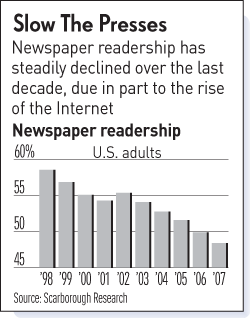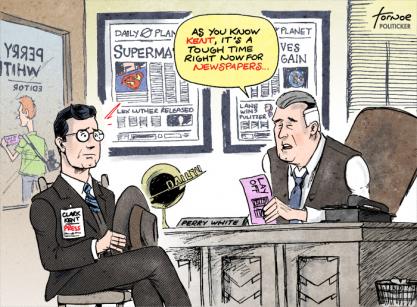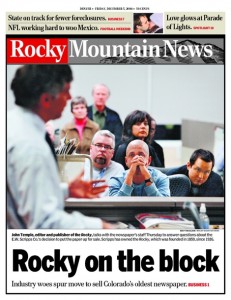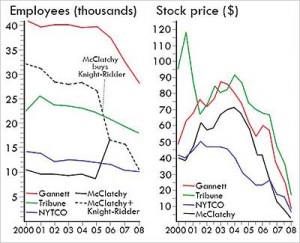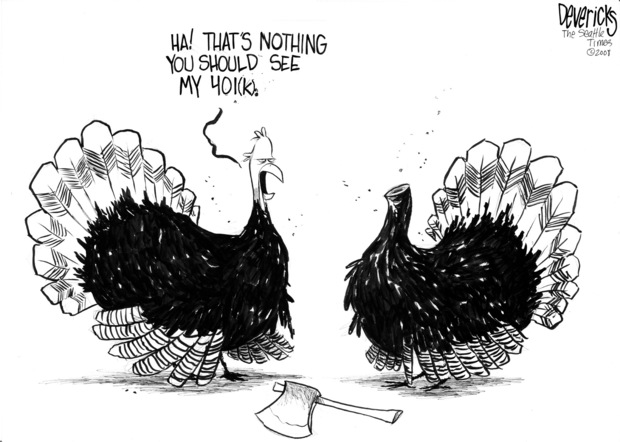Don’t forget to take our poll: Will the Detroit Experiment Succeed?
Writing in Fortune, Richard Siklos has the most perceptive analysis of the Tribune Co. ownership picture we’ve seen. Siklos scores Sam Zell for his hubris and for characterizing his company as employee-owned when the only votes that counted were his and those of the former shareholders who approved the transfer of Tribune shares to a toothless employee stock option plan. What happens to those employee-owners now, Siklos asks? Barring an unlikely market turn, they’ll lost most or all of their investment, leaving them just with their 401(k) holdings. In all fairness, Sam Zell also stands to lose his investment, Siklos points out, although we doubt they’re stocking up on the macaroni & cheese at the Zell mansion. This brief, insight-packed piece ends by speculating that Tribune Co. will emerge from bankruptcy with about a $4 billion valuation. At that price, Zell may actually be tempted to put in some more money. Eeek!
2009 Forecasts Offer Little To Smile About
Researchers quit using euphemisms to describe the industry’s troubles some time ago. Now they vie to see who can come up with the strongest adjectives. “Terrible” is how Kubas Consultants describes the newspaper ad revenue outlook for 2009 after surveying 400 newspaper executives. The report offers a “very negative outlook” because a “disaster area” is looming in employment classifieds. Seemingly at a loss for more superlatives, the report summarizes: “the severity of expected declines is remarkable.” All this for a forecast of a 9.1% decline in revenues in 2009, which would actually be less than the 2008 wreckage to date. It’s the cumulative effect that invokes shock and awe, though. “If Kubas’ predictions for 2009 come to pass, by the end of next year, newspapers will have lost about 30% of their total revenues in four years,” says MediaPost. This story has no hope in it. If you’re hoping for a nice weekend, read something else.
Scribes Sum Up Industry Woes In Painful Detail
“Across the U.S., more than 30 papers are up for sale, but there are no buyers,” sums up a long piece from Britain’s Independent that’s kind of a Wikipedia entry for newspaper industry turmoil. Regular readers of this blog and others like it won’t find a lot of new information in Stephen Foley’s 1,900-word opus, but the piece is a nice digest of the events of 2008.
Particularly notable is its description of the travesty that was Sam Zell’s purchase of Tribune Co. just 19 months ago. Foley dug up some choice Zell boasts about how his deal didn’t require the stars to line up perfectly in order to succeed, while Rupert Murdoch’s Wall Street Journal acquisition did. Fast forward to today and look who’s laughing. The Journal‘s circ is holding steady and Murdoch is actually investing in the paper while Tribune Co. is in court receivership. “Sam Zell is a demonstration of the proposition that a group of people that knows nothing about the newspaper business going in, is unlikely to be successful,” says Poynter’s Rick Edmonds in the story’s best quote.
Solutions? Sadly, the piece turns up nothing new, other than the idea of putting some papers into a not-for-profit trust, as the St. Petersburg Times has done. The nonprofit ideas may have some merit, since profits won’t be an issue before long, anyway. Why not call a spade a spade?
Maybe it’s because the new year’s drawing close, but this is certainly the week for epic analyses of the state of the industry. The Toledo Free Press kicks in a rambling 1,700-word essay with lots of facts but little new perspective. And the headline, “Changing media landscape causing problems, new opportunities in Toledo and nationwide,” appears to have been written by a search engine.
The story has one great quote, though, from FOX Toledo’s President/General Manager Ray Maselli in response to a question about recent layoffs: “We are adjusting to the needs of our environment and re-engineering the way we do business. WUPW’s ongoing investments in operational efficiency as well as our commitment to serving viewers and advertisers with optimal products and services are effectively positioning us as a more diversified, multi-media news organization.” We think “investments in operational efficiency” is the best euphemism for “layoff” we’ve seen all year.
Plain Dealer Kicks Laid Off Employees When Down
The 2008 Conflict Avoidance Trophy goes to the Cleveland Plain Dealer for the surreal way in which it handled the layoffs of a dozen people. Management turned an already unpleasant task into a humiliating water torture for the entire staff and then kicked the sacked employees when they were down.
Cleveland Scene has the details. As we noted earlier, the Plain Dealer staff was told not to come in to work until after 9:30 a.m. on Dec. 2. Laid-off employees were notified by phone. So if someone didn’t call to say you were out of a job, you were expected to come in to the office. And smile, dammit! As if that wasn’t bad enough, management arranged for laid-off employees to clean out their desks on a Saturday morning and to enter the building from the back where they would attract the least attention. “For some, decades of service ended like a protected, shameful secret,” writer D.X. Ferris sums up.
Ferris showed up in the P D parking to try to interview the sacked employees but they told him to bug off. That’s not surprising under the circumstances: People with some of the most well-recognized names in Cleveland being hustled out the back door so no one would have to witness their shame. It doesn’t get much more humiliating than that.
Miscellany
The Milwaukee Journal Sentinel has laid off 39 employees at the newspaper and affiliated community publishing group as part of an ongoing plan to cut staff by 10% before the end of the year.
The Pittsburgh Post-Gazette is offering a buyout package to all 200 of its Guild employees. Management said the offer is being made to avoid layoffs, which is management shorthand for saying there are probably going to be more layoffs.
We were interviewed by freelancer Michelle Rafter for her blog WordCount – Freelancing in the Digital Age (freelancers need all the support they can get these days). The focus was on community news, which is a mixed bag of an industry these days. While it seems that big publishers like Gannett and Journal Register can’t be bothered with community newspapers at the moment, some of the most innovative work is actually going on there.
Faced with devastating cuts to their arts coverage, the Dallas Morning News and the Fort Worth Star-Telegram have teamed up to share reporting resources, according to a local blog called Art&Seek. The deal means that some local music and theatre will continue to get newspaper coverage that would have otherwise been lost, but some members of the arts community also fear that the loss of competing perspectives will put too much influence in the hands of too few critics.
An expected write-down at Lee Enterprises could force the troubled owner of the St. Louis Post-Dispatch and other newspapers into default on $306 million in debt, the St. Louis Business Journal reports.
Last month we told you about Helium, a citizen journalism site that’s seeking to partner with newspapers to provide what is essentially high-quality blog content. Now the Lawrence (Mass.) Eagle-Tribune has become Helium’s second customer. The paper will use Helium’s writer’s marketplace to find and contract with local stringers “who are compensated for contributing articles on a variety of topics ranging from wedding planning tips to great day trips with your kids, to seasonal gardening advice and concert reviews.” While this isn’t exactly hard-hitting journalism, it is going to cost the Eagle-Tribune a lot less than paying professional writers.
And Finally…
If the rapidly developing world of social media has you feeling dazed and confused, you’re not alone. There are so many new websites and so little time to drink them all in. Boston interactive agency Overdrive Interactive is trying to help with Social Media Map, a visual guide to the most essential social media resources that resembles a really dense version of the New York City subway system. You can download the clickable PDF here.
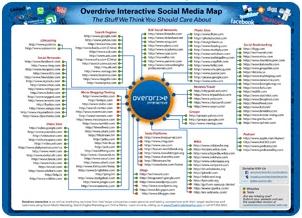
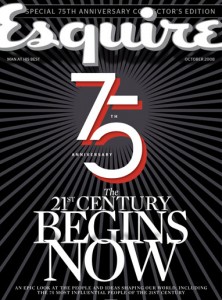 Esquire‘s 75th anniversary issue in October was a media sensation for its battery-powered cover and fat ad folio. But
Esquire‘s 75th anniversary issue in October was a media sensation for its battery-powered cover and fat ad folio. But 
